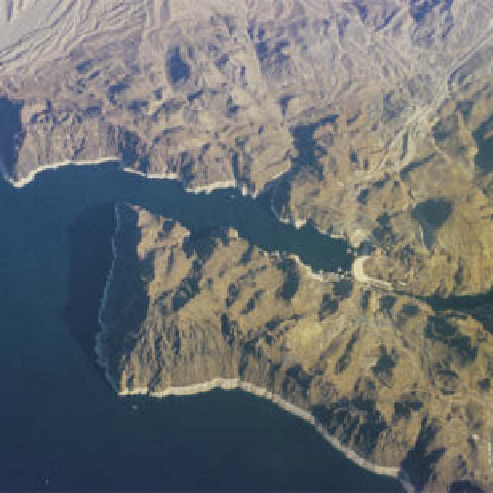Geoscience Reference
In-Depth Information
(very likely, 90-99 per cent probability); changes in the
frequency and intensity of storms (likely, 66-90 per cent
probability) (
Figure 28.6
).
There are several ways of
assessing or modelling the probability of responses to
particular stimuli, with the focus on extreme events
which cross critical thresholds. Environmental records of
events with near-normal distributions of frequency and
magnitude suggest that small changes in magnitude lead
to larger (non-linear, but not quite exponential) increases
in their frequency. The likely impact of climate-driven
changes also depends on the
adaptive capacity
(resilience)
or
vulnerability
(
susceptibility
, or inability to cope) of the
existing state of the system in question. Armed with all
this and a general sense of the directions of climate
change, whilst accepting regional variability and ±
directions of change, it is possible to identify the following
probable trends.
Catchments, rivers and arid environments
Two very likely and direct consequences of global warm-
ing for terrestrial hydrology are higher surface run-off and
river discharge fed by more precipitation (driven by
increasing net evaporation) and ice melt. This inevitably
increases flood risk, higher sediment discharge and the
risk of channel destabilization, particularly where they
coincide with an increasing frequency of higher-intensity
rainfall events. There is less certainty surrounding the geo-
graphical distribution of hydrometeorological changes
than for temperature in the climate change scenarios, and
more complex ± feedback mechanisms such as the effect
on humidity of surface cooling under higher cloud cover.
Despite this, we can still predict major regional trends
with high confidence.
The picture for Europe is quite complex, with reduced
precipitation and increasing drought in southern,
Mediterranean areas contrasting with increasing precipi-
tation in northern Europe. The hydrological impact is
more complex, however, once trends in seasonality and
intensity are taken into account. Flood frequencies,
associated with higher winter precipitation, are forecast
to rise in northern European winters but there is a greater
risk of flash floods in central, eastern and southern Europe
from higher storm intensity, despite increasing summer
aridity. Britain lies astride these zones, with higher winter
precipitation especially in the north-west and lower but
potentially more intense summer precipitation in the
south-east, as the 2007 floods demonstrated (see box,
Chapter 14,
p. 333).
Significant changes in run-off are expected elsewhere
due to precipitation trends in the humid tropics, arid
subtropics, monsoon and ENSO systems, in alpine regions
Colorado river at the Nevada-Arizona border, south-west
United States.
Photo: Ken Addison
effect of postglacial ecosystem developments. This
inevitably creates a complex mosaic of small but signif-
icant, in-progress land surface changes at decadal to
centennial time scales, even before adding the complexity
of direct human modification and the indirect impacts of
anthropogenic climate change! The purpose of this section
is to provide educated glimpses of the future, not to
engage in detailed scenarios. In one sense, therefore,
forecasting geomorphic impacts runs the risk of being
speculative and alarmist - especially when the exact
timing, location and extent of climate change scenarios
are themselves subject to some uncertainty. However, it is
also possible to apply scientific logic to the operation of
geomorphic systems to identify some general trends.
The essential atmospheric changes are those of net
warming, leading to net increased global evapotranspi-
ration but with the clear implication that some areas will
experience regional cooling and increased aridity. These
are relayed to the land surface by atmospheric circulation
systems, individual weather events and disturbances which
also undergo alterations in direction and intensity. The key
implications for geomorphic processes are: increasing
atmospheric temperature and altered thermal regimes
(virtually certain,
99 per cent probability); changes
in humidity, precipitation type, amount and regime
(intensity, frequency and duration) and aridity indices









































